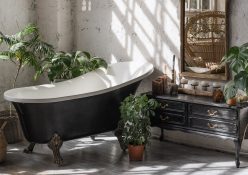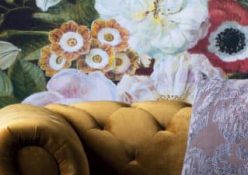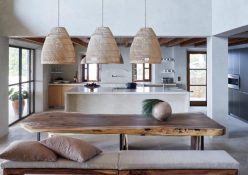The decor in this holiday home near South Africa’s famous Kruger National Park captures the beauty of its setting – the vast plains of Limpopo
Even though you might leave Africa, Africa never leaves you,’ says South African-born Julian Koski. He left South Africa for the US as a young man in the 1980s, but his vivid memories of his childhood safari holidays stayed with him. Now, living with his wife Aida in New York City, working on Wall Street and raising a family of his own – twins Leo and Tess – his thoughts turned once again to his childhood memories of the South African wilderness. ‘I wanted to give them a piece of what I had as a child growing up,’ he says. He saw the potential for a holiday home in a nature reserve, forming part of the Greater Kruger National Park, to open up another realm for them, a counterpoint to the built-up, non-stop pace of New York City. ‘We wanted to give them a different perspective of the world – something environmental, ecological, human,’ he says. He found a spectacular site overlooking a dam in Thornybush Private Game Reserve, pristine savannah adjacent to the Kruger Park, and began the process that would realise his dream of a family base in Africa.

If there’s one thing that Julian loves as much as a safari holiday, it’s architecture. ‘My whole life, I wanted to become an architect,’ says Julian. ‘It was always my passion, and this was an opportunity for me to exercise my architectural ambitions.’ So, he set about designing his family’s holiday home himself. Although Julian says he didn’t have a preconceived notion of a ‘dream house’, he wanted to make some sort of reference to his family in the architecture. The concept was inspired by the idea of a family legacy. ‘Me being South African, and my wife being part Arabic, part Brazilian, we wanted to merge the north and south of Africa,’ he says. ‘I bring a sub-Saharan feel; she brings that North-African feel – the more Moorish side of it. So, really, it’s the marriage of the two to make a whole.’
In addition to these personal references, the very heart of Julian’s design was the mesmerising power of the ruins of Great Zimbabwe, the medieval city in the heart of Africa, and, according to some legends, the capital of the land of the Queen of Sheba. The rough-hewn granite stones of the disintegrating ancient city inspired Julian. ‘I’ve always been intrigued by rock work,’ says Julian. ‘I love rock.’
Julian wanted to capture the aura of legend and of ancient African civilisations, but building a house from scratch in the pristine wilderness demands a complex response. Immediately one can tell that Julian’s vision for this home was to be a geological construction that echoes the landscape. When it was complete, he and Aida christened the house Kubili House – ‘kubili’ means ‘two’ in Tsonga, – in reference to the twins Leo and Tess. But the house is in many ways about dualities.

Julian conceived of the house in two parts, drawing on ancient and modern influences: earthy, organic materiality expressed in abstract, modernist-inspired forms. One part is a giant open pergola with a floating roof, and the other is its rocky counterpart where the more ‘Moorish, Moroccan, Zimbabwean-ruins type of look’ comes in. They mirror each other across a rim-flow pool and koi ponds; you cross from one section to the other via three large stepping stones over the pond. ‘That was the perfect marriage,’ says Julian, ‘Taking a modernist architectural idea and marrying it with something that’s very Moorish.’
In the pergola, it’s as if the rocks are giving way to the smooth finishes of the floors and suspended ceilings. This space is all about openness and looking out. The furniture here is low to the ground. The fireplace, too, is on the ground, beneath a massive chimney dome custom-made and inspired by the brass bells in the temples of Kyoto. It’s almost as if the furniture immerses you in the landscape. ‘Everyone sits low, almost at floor level,’ says Julian. ‘The idea is that you don’t want to be up, above the animals. You want to be at the eye level of the animals passing by.’

 Subscribe to Livingspace, to receive monthly updates on all decor trends.
Subscribe to Livingspace, to receive monthly updates on all decor trends.





